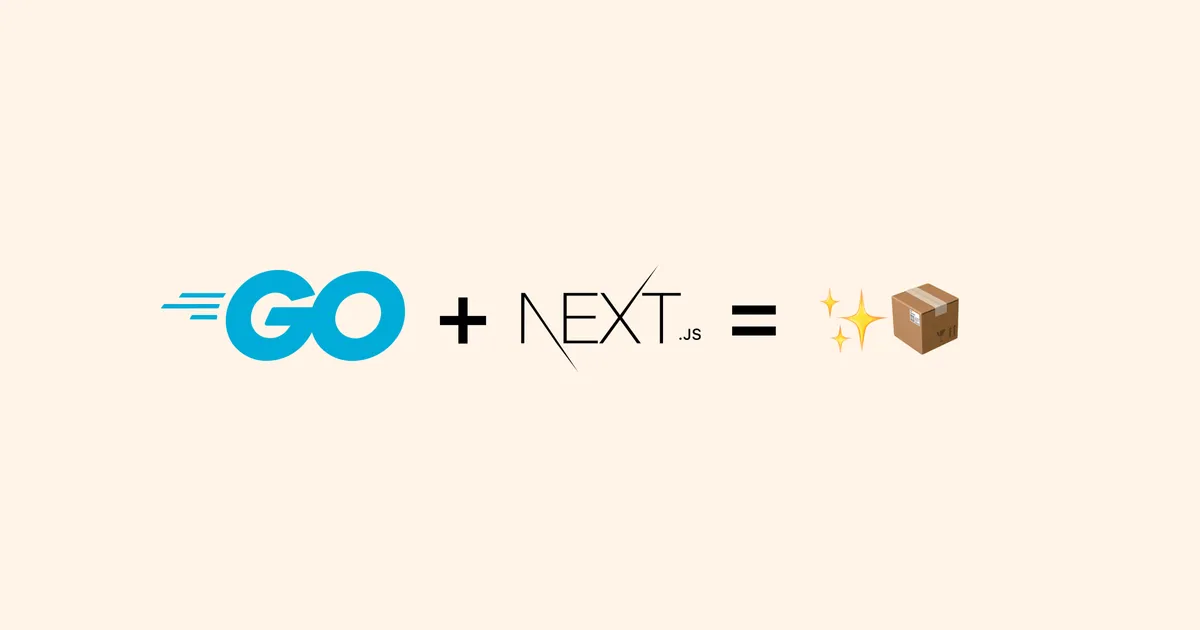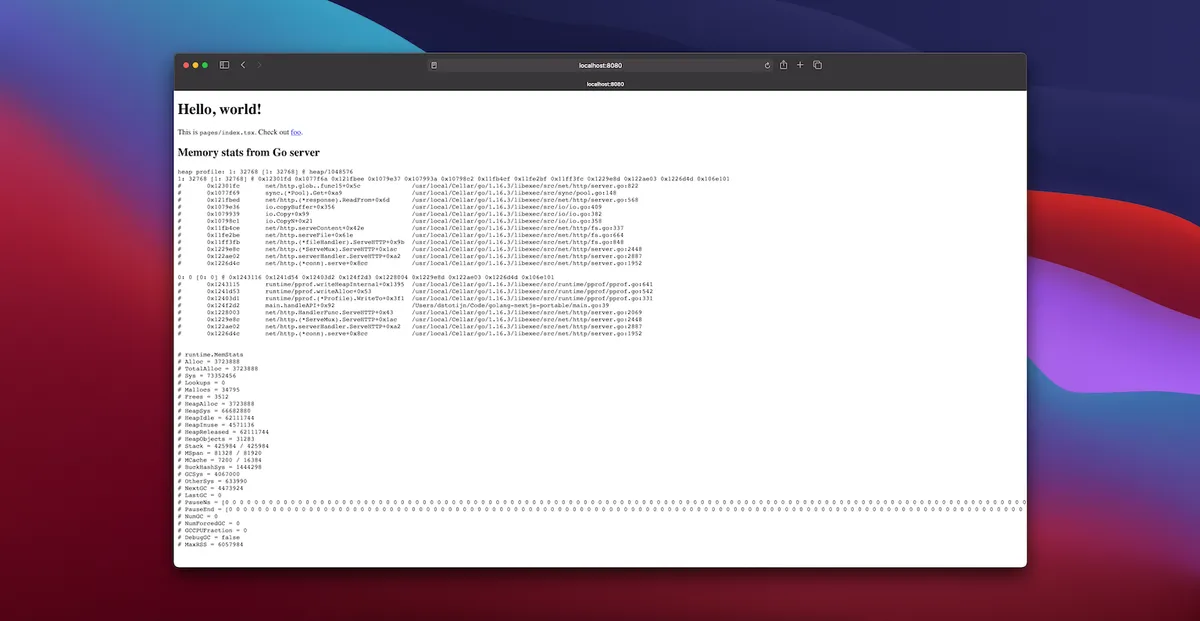Portable apps with Go and Next.js
The release of Go 1.16 introduced a new
embed package in the Go standard library. It
provides access to files embedded in a Go program at compile time using the new
//go:embed directive. It’s a powerful new feature because it allows building a
binary with static dependencies like templates, HTML/CSS/JS, or images
self-contained. This portability is great for easy distribution and usage.
Previously, developers had to rely on third-party libraries for embed behaviour.
In this article we’ll walk through a small demo app, golang-nextjs-portable, that exposes an HTTP server that hosts both an API endpoint, as well as an embedded (Next.js) web app that calls the API.
👉 The source code of the final result is hosted on GitHub.

Embedding a web UI
An interesting use case for the embed package is bundling a web UI in your Go
program. A web frontend can have some advantages over a terminal-based UI (TUI).
For example, you can run the HTTP server in your home network, and access it
from any browser across (mobile) devices. It can also empower you to build
user-friendly UI/UX, leveraging web technologies that browsers natively support.
When building a hybrid between offline/self-hosted and SaaS, it makes it
possible to reuse the same code across self-contained binaries (e.g. for IoT or
Raspberry Pi devices) and a hosted/SaaS platform.
Building the Go program
The Go program for our demo project is a relatively simple main.go file:
package main
import (
"embed"
"io/fs"
"log"
"net/http"
"runtime/pprof"
)
//go:embed all:nextjs/dist
var nextFS embed.FS
func main() {
// Root at the `dist` folder generated by the Next.js app.
distFS, err := fs.Sub(nextFS, "nextjs/dist")
if err != nil {
log.Fatal(err)
}
// The static Next.js app will be served under `/`.
http.Handle("/", http.FileServer(http.FS(distFS)))
// The API will be served under `/api`.
http.HandleFunc("/api", handleAPI)
// Start HTTP server at :8080.
log.Println("Starting HTTP server at http://localhost:8080 ...")
log.Fatal(http.ListenAndServe(":8080", nil))
}
func handleAPI(w http.ResponseWriter, _ *http.Request) {
// Gather memory allocations profile.
profile := pprof.Lookup("allocs")
// Write profile (human readable, via debug: 1) to HTTP response.
err := profile.WriteTo(w, 1)
if err != nil {
log.Printf("Error: Failed to write allocs profile: %v", err)
}
}It uses the http package to run a simple HTTP web server on port :8080. The
API is served under /api and returns a text response with current memory
allocation stats.
Using the embed package
To embed files into our Go program, we’ll use the standard library embed
package, introduced in Go 1.16. See the
package docs for details.
We’ll use the //go:embed directive like so:
//go:embed all:nextjs/dist
var nextFS embed.FSThe directory nextjs/dist will contain the static HTML export of the Next.js
app (see “The export script” in the next section).
The all: prefix (added in Go 1.18) ensures that any files or directories
prefixed with . or _ are included:
If a pattern begins with the prefix ‘all:’, then the rule for walking directories is changed to include those files beginning with ‘.’ or ‘_’. For example, ‘all:image’ embeds both ‘image/.tempfile’ and ‘image/dir/.tempfile’.
(Source: embed package docs)
Because a static HTML export of a Next.js app contains various directories and
files prefixed with _, we need this rule behavior.
At compile time, the matched files are embedded in the binary. The
embed.FS type implements
fs.FS, which was also introduced in Go
1.16. Because we want to serve the static HTML export at /, we’ll use
fs.Sub. This method returns a fs.FS
value that (under the hood) maps to the subtree nextjs/dist).
// Root at the `dist` folder generated by the Next.js app.
distFS, err := fs.Sub(nextFS, "nextjs/dist")
if err != nil {
log.Fatal(err)
}
// The static Next.js app will be served under `/`.
http.Handle("/", http.FileServer(http.FS(distFS)))Building the Next.js app
For this article, I’m going to skip setting up and scaffolding a Next.js app. We’ll only cover the relevant code and configuration for our embedding purposes:
Making API requests
The homepage of our app will fetch memory allocation stats from the (Go) HTTP
server, which exposes an /api route. We’ll use
swr, a lightweight React Hook for fetching data. We
fetch using only the path, which will cause the request to made to the server
that’s rendering the current HTML page. This is convenient because fetching will
work both when running Next.js in development (using its own Node.js web server,
by default on :3000) as well as via the Go HTTP server, covered in the next
section.
import Link from "next/link";
import useSWR from "swr";
async function fetcher(url: string) {
const resp = await fetch(url);
return resp.text();
}
function Index(): JSX.Element {
const { data, error } = useSWR("/api", fetcher, { refreshInterval: 1000 });
return (
<div>
<h1>Hello, world!</h1>
<p>This is <code>pages/index.tsx</code>.</p>
<p>Check out <Link href="/foo">foo</Link>.</p>
<h2>Memory allocation stats from Go server</h2>
{error && <p>Error fetching profile: <strong>{error}</strong></p>)}
{!error && !data && <p>Loading ...</p>}
{!error && data && <pre>{data}</pre>}
</div>
);
}
export default Index;Proxying API requests in dev mode
When running Next.js in development via next dev, it spawns a Node.js server
serving the app (with live reloading) at :3000. When our fetch code runs, it
will make a GET request to
http://localhost:3000/api. Obviously, this won’t
work out of the box; the Next.js dev server will attempt to serve
pages/api.tsx, which doesn’t exist. What we want is requests to /api to be
proxied to our Go server, which we’ll run on :8080. That way we don’t have
to constantly do a manual export every time we make a change to our Next.js
code.
The proxy configuration can be defined in nextjs/next.config.js:
module.exports = {
async rewrites() {
// When running Next.js via Node.js (e.g. `dev` mode), proxy API requests
// to the Go server.
return [
{
source: "/api",
destination: "http://localhost:8080/api",
},
];
},
};Note: Changes to next.config.js only take effect when restarting the Next.js
dev server.
The steps for running Next.js in dev mode (with live reloading) are:
- First, create an export of the Next.js app using
yarn run export. We need to do this first/once because the Go program will only compile if there are files to embed. - Run the Next.js dev server:
yarn run dev. - Build/run the Go program, using
go run main.go. - Access the app via http://localhost:3000. The API
requests to
/apishould be proxied to the Go server running on:8080.
The export script
Next.js has first class support for static HTML export. Typically it’s used to deploy on a static hosting service or CDN. In our use case, we’ll embed the export in a Go program.
By default, running next export will write to an out directory. I prefer the
name dist. To prevent unneeded bundle contents for repeated exports after
updating JS imports, we’ll want to remove the .next directory before
generating a static export. We an export npm script as follows:
{
(...)
"scripts": {
(...)
"export": "rm -rf .next && next build && next export -o dist"
}
}Now, running yarn run export will result in a static HTML export written to a
nextjs/dist directory. Note: Next.js recreates the export directory each
time when repeatedly exporting, so there’s no need to manually remove it.
Build & distribute
After adding both the Go program and the Next.js app to our code repository, we end up with the following directory structure.
./golang-nextjs-portable
├── go.mod
├── main.go <- Go program
└── nextjs
├── dist <- Export directory created with `yarn run export`
├── next-env.d.ts
├── next.config.js
├── package.json
├── package.json
├── pages <- Next.js pages
│ ├── foo
│ │ ├── bar.tsx
│ │ └── index.tsx
│ └── index.tsx
├── tsconfig.json
├── tsconfig.json
└── yarn.lockBuilding
Building consists of two steps: generating the static HTML export, and building the Go program:
$ cd nextjs
$ yarn run export
$ cd ..
$ go build main.goThis generates an executable golang-nextjs-portable file.
Running
To run the program, we simply execute the binary:
$ ./golang-nextjs-portable
2021/04/27 14:55:38 Starting HTTP server at http://localhost:8080 ...When you open the web interface via http://localhost:8080, you should see the statically generated HTML page, with live memory allocation stats coming from our API, refreshed every second:

Dockerfile
To create a streamlined Docker image for our portable app, we create a
Dockerfile:
ARG GO_VERSION=1.18
ARG NODE_VERSION=14.16.1
ARG ALPINE_VERSION=3.13.5
FROM node:${NODE_VERSION}-alpine AS node-builder
WORKDIR /app
COPY nextjs/package.json nextjs/yarn.lock ./
RUN yarn install --frozen-lockfile
COPY nextjs/ .
ENV NEXT_TELEMETRY_DISABLED=1
RUN yarn run export
FROM golang:${GO_VERSION}-alpine AS go-builder
WORKDIR /app
COPY go.mod main.go ./
COPY --from=node-builder /app/dist ./nextjs/dist
RUN go build .
FROM alpine:${ALPINE_VERSION}
WORKDIR /app
COPY --from=go-builder /app/golang-nextjs-portable .
ENTRYPOINT ["./golang-nextjs-portable"]
EXPOSE 8080To keep the final image size down, we use multi-stage builds. The total image size of this demo app is 13MB, including all resources needed to run the app. Not bad!
Closing thoughts
I’ve used the approach outlined in this article for Hetty, a project that uses Go for its core behaviour, and Next.js for the web interface. For me, this offers the best of both worlds: using Go for general-purpose programming and its amazing standard library, and HTML/JS/CSS with its ever evolving ecosystem of UI and UX tooling. Be mindful of the cohesion between server and client though. Using some contract between the two (GraphQL, protobuf, JSON schema) is advised for larger/real-world projects.
On the other hand, bundling a web app can be complete overkill if your Go program doesn’t have elaborate UI/UX needs. As with almost everything: “it depends”.
Do you have any corrections/suggestions? Please get in touch!